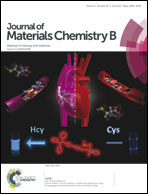Amphiphilic miktoarm star copolymer (PCL)3-(PDEAEMA-b-PPEGMA)3 as pH-sensitive micelles in the delivery of anticancer drug†
Abstract
Well-defined A3(BC)3 type amphiphilic miktoarm star polymers poly(ε-caprolactone)3-[poly(2-(diethylamino)ethyl methacrylate)-b-poly(poly(ethylene glycol) methyl ether methacrylate)]3 [(PCL)3-(PDEAEMA-b-PPEGMA)3] and their pH-sensitive self-assembled polymeric micelles were developed as anticancer vehicles for improved cancer therapy. These miktoarm star polymers were synthesized by a combination of ring opening polymerization (ROP) and continuous activators regenerated by electron transfer atom transfer radical polymerization (ARGET ATRP) and characterized by GPC and 1H NMR measurement. The CMC values of the miktoarm star polymers in aqueous solution were extremely low (0.0029–0.0035 mg mL−1), suggesting that the micelles are relatively stable in solution. The self-assembled blank and doxorubicin (DOX)-loaded micelles were spherical in morphology with average sizes of 110–240 nm depending on the architecture of the copolymers, which were determined by transmission electron microscopy (TEM) and dynamic light scattering (DLS). When decreasing pH from 7.4 to 5.0, the micelles underwent globule–uneven–extended conformational transitions, and in vitro drug release rates were significantly accelerated, owing to the swelling of micelles at lower pH conditions caused by the protonation of tertiary amine groups of DEAEMA. Moreover, the drug release profiles at different pH values were well fitted by a semi-empirical equation. The in vitro cytotoxicity of DOX-loaded micelles against HepG2 cells suggested that DOX-loaded (PCL)3-(PDEAEMA-b-PPEGMA)3 micelles exhibited similar anti-tumor activities to free DOX, with at least 80% decrease in cell viability after 48 h incubation. Intracellular uptake demonstrated that DOX was delivered into the cells effectively after the cells were incubated with DOX-loaded micelles. The results demonstrated that the pH-responsive (PCL)3-(PDEAEMA-b-PPEGMA)3 micelles could be used as latent vehicles for delivering hydrophobic anticancer drugs with controlled and sustained release behavior.


 Please wait while we load your content...
Please wait while we load your content...